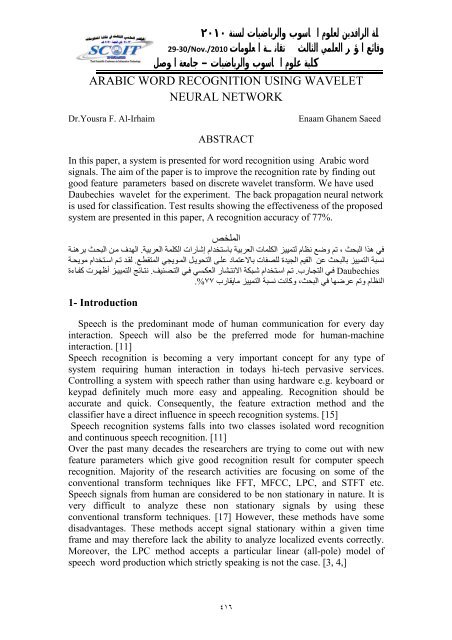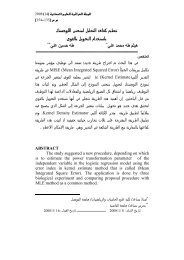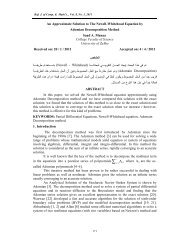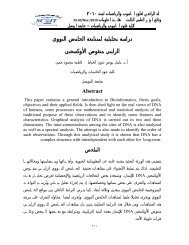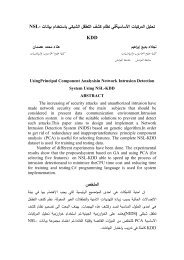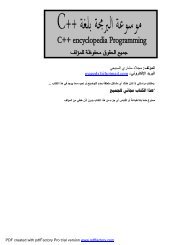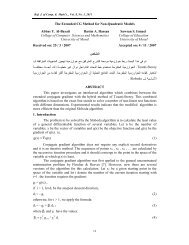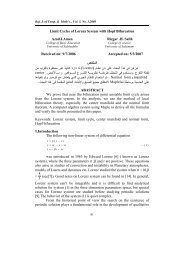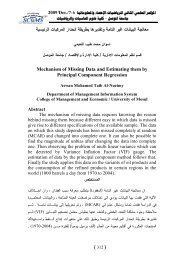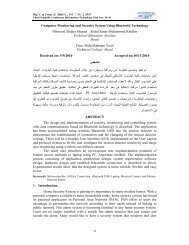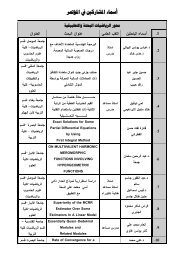arabic word recognition using wavelet neural network
arabic word recognition using wavelet neural network
arabic word recognition using wavelet neural network
Create successful ePaper yourself
Turn your PDF publications into a flip-book with our unique Google optimized e-Paper software.
مجلة الرافدين لعلوم الحاسوب والرياضيات لسنة ٢٠١٠<br />
وقائع المؤتمر العلمي الثالث في تقانة المعلومات<br />
كلية علوم الحاسوب والرياضيات – جامعة الموصل<br />
29‐30/Nov./2010<br />
ARABIC WORD RECOGNITION USING WAVELET<br />
NEURAL NETWORK<br />
Dr.Yousra F. Al-Irhaim<br />
Enaam Ghanem Saeed<br />
ABSTRACT<br />
In this paper, a system is presented for <strong>word</strong> <strong>recognition</strong> <strong>using</strong> Arabic <strong>word</strong><br />
signals. The aim of the paper is to improve the <strong>recognition</strong> rate by finding out<br />
good feature parameters based on discrete <strong>wavelet</strong> transform. We have used<br />
Daubechies <strong>wavelet</strong> for the experiment. The back propagation <strong>neural</strong> <strong>network</strong><br />
is used for classification. Test results showing the effectiveness of the proposed<br />
system are presented in this paper, A <strong>recognition</strong> accuracy of 77%.<br />
الملخص<br />
في هذا البحث تم وضع نظام لتمييز الكلمات العربية باستخدام إشارات الكلمة العربية. الهدف من البحث برهنة<br />
نسبة التمييز بالبحث عن القيم الجيدة للصفات بالاعتماد على التحويل المويجي المتقطع. لقد تم استخدام مويحة<br />
Daubechies في التجارب. تم استخدام شبكة الانتشار العكسي في التصنيف. نتائج التمييز أظهرت آفاءة<br />
النظام وتم عرضها في البحث، وآانت نسبة التمييز مايقارب ٧٧%.<br />
1- Introduction<br />
Speech is the predominant mode of human communication for every day<br />
interaction. Speech will also be the preferred mode for human-machine<br />
interaction. [11]<br />
Speech <strong>recognition</strong> is becoming a very important concept for any type of<br />
system requiring human interaction in todays hi-tech pervasive services.<br />
Controlling a system with speech rather than <strong>using</strong> hardware e.g. keyboard or<br />
keypad definitely much more easy and appealing. Recognition should be<br />
accurate and quick. Consequently, the feature extraction method and the<br />
classifier have a direct influence in speech <strong>recognition</strong> systems. [15]<br />
Speech <strong>recognition</strong> systems falls into two classes isolated <strong>word</strong> <strong>recognition</strong><br />
and continuous speech <strong>recognition</strong>. [11]<br />
Over the past many decades the researchers are trying to come out with new<br />
feature parameters which give good <strong>recognition</strong> result for computer speech<br />
<strong>recognition</strong>. Majority of the research activities are foc<strong>using</strong> on some of the<br />
conventional transform techniques like FFT, MFCC, LPC, and STFT etc.<br />
Speech signals from human are considered to be non stationary in nature. It is<br />
very difficult to analyze these non stationary signals by <strong>using</strong> these<br />
conventional transform techniques. [17] However, these methods have some<br />
disadvantages. These methods accept signal stationary within a given time<br />
frame and may therefore lack the ability to analyze localized events correctly.<br />
Moreover, the LPC method accepts a particular linear (all-pole) model of<br />
speech <strong>word</strong> production which strictly speaking is not the case. [3, 4,]<br />
،<br />
٤١٦
مجلة الرافدين لعلوم الحاسوب والرياضيات لسنة ٢٠١٠<br />
وقائع المؤتمر العلمي الثالث في تقانة المعلومات<br />
كلية علوم الحاسوب والرياضيات – جامعة الموصل<br />
29‐30/Nov./2010<br />
The Wavelet Transform overcomes some of these limitations; it can provide a<br />
constant-Q analysis of a given signal by projection onto a set of basis functions<br />
that are scale variant with frequency. Each <strong>wavelet</strong> is a shifted scaled version<br />
of an original or mother <strong>wavelet</strong>. These families are usually orthogonal to one<br />
another, important since this yields computational efficiency and ease of<br />
numerical implementation. Other factors influencing the choice of Wavelet<br />
Transform over conventional methods include their ability to capture localized<br />
features. Also, developments aimed at generalization such as the Best-Basis<br />
Paradigm of Coifman and Wickerhauser make for more flexible and useful<br />
representation.[3,15,4,17]<br />
Neural Network is well-known as a technique that has the ability to classified<br />
nonlinear problem. Today, lots of researches have been done in applying<br />
Neural Network towards the solution of speech <strong>recognition</strong> such as Arabic. The<br />
Arabic language offers a number of challenges for speech <strong>recognition</strong>. [1]<br />
ANN is a fast emerging technology. Its ability to compute complex decision<br />
surfaces and its numerous processing elements have given it the ability to<br />
classify objects and make complex decisions. [7, 9]<br />
Generally, there are three usual methods in speech <strong>recognition</strong>: Dynamic Time<br />
Warping (DTW) Model, Hidden Markov Model (HMM) and Artificial Neural<br />
Networks (ANNs). Nowadays, ANNs are utilized in wide ranges for their<br />
parallel distributed processing, distributed memories, error stability, and pattern<br />
learning distinguishing ability . [10]<br />
The Wavelet Transform theory and its implementation are limited to the<br />
<strong>wavelet</strong>s of the small dimension, where as the ANN are the powerful tools for<br />
handling the problem of higher dimension. Combination of both results in<br />
Wavelet <strong>network</strong>. The weakness of each other compensates and it can handle<br />
problems of larger dimension and it also shows efficient <strong>network</strong> construction<br />
methods.[17,14] In several studies, a <strong>wavelet</strong> <strong>neural</strong> <strong>network</strong> was used for<br />
speech <strong>recognition</strong>.[4]<br />
This paper presents a method of the <strong>wavelet</strong>-<strong>neural</strong> <strong>network</strong> for Arabic <strong>word</strong><br />
<strong>recognition</strong>. The discrete <strong>wavelet</strong> transform is used to extract features of<br />
analyzed speech signals. Then based on extracted features, a <strong>neural</strong> <strong>network</strong> is<br />
used for pattern <strong>recognition</strong> approximation. So Arabic <strong>word</strong> signals are used<br />
for obtaining the data sets. The <strong>word</strong> signals are transmitted to the computer by<br />
<strong>using</strong> a microphone and an audio card which has 11 KHz sampling frequency.<br />
2- Architecture Of System<br />
A speech <strong>recognition</strong> system consists of two main parts: training unit and<br />
testing unit. Training speech data is input in the training unit which generates a<br />
model. This model then used by testing unit. The testing speech data is fed to<br />
the testing unit which performs pattern matching <strong>using</strong> the model obtained<br />
from the training unit. The speech data is pre-processed and set of features are<br />
extracted from the speech data. [16] The proposed system here is implemented<br />
٤١٧
مجلة الرافدين لعلوم الحاسوب والرياضيات لسنة ٢٠١٠<br />
وقائع المؤتمر العلمي الثالث في تقانة المعلومات<br />
كلية علوم الحاسوب والرياضيات – جامعة الموصل<br />
29‐30/Nov./2010<br />
<strong>using</strong> matlab 6.1. The architecture of our speech <strong>recognition</strong> system has been<br />
shown below in figure(1) .<br />
Our speech <strong>recognition</strong> process contains three main stages:<br />
1- Preprocessing.<br />
2- Feature extraction from <strong>wavelet</strong> transforms coefficients.<br />
3- Classification and <strong>recognition</strong> <strong>using</strong> back propagation learning<br />
algorithm.<br />
Data Recording<br />
Preprocessing<br />
Feature Extraction<br />
Classification by NN<br />
2-1 Preprocessing<br />
Fig(1): System Architecture<br />
The analog speech signals are recorded <strong>using</strong> microphone, converted and<br />
stored into digital speech signal. The stored speech signal is in the form of<br />
wave files as shown in figure(2). The speech samples thus obtained are stored<br />
for further computation.<br />
Audio sampling rate 11 kHz<br />
Audio sampling rate size 16 bit<br />
2-1-1 Windowing<br />
Fig (2):The wav file of the <strong>word</strong> ”قام“ for the male speaker<br />
٤١٨
مجلة الرافدين لعلوم الحاسوب والرياضيات لسنة ٢٠١٠<br />
وقائع المؤتمر العلمي الثالث في تقانة المعلومات<br />
كلية علوم الحاسوب والرياضيات – جامعة الموصل<br />
29‐30/Nov./2010<br />
The Speech signal is multiplied by an appropriate times window when<br />
dividing it into frames. Windowing process gradually attenuates the amplitude<br />
at both ends of the extraction interval to prevent an abrupt change at the<br />
endpoints . A Rectangular Window is used [5,2]<br />
…………………..(1)<br />
2-1-2 Edge Detection<br />
A simple algorithm based on amplitude detection is used here. A <strong>word</strong><br />
is considered as started if the amplitude crosses over a pre-defined threshold<br />
value. Until the amplitude of the speech signal remains over this threshold<br />
value, the signal is considered to be in the voiced region. When the signal<br />
amplitude stays below the threshold for a predefined time, the end of the signal<br />
is detected. This value is selected in such a way that it would not mistakenly<br />
cut off the speech signal in an intermediate point.[12] As shown in figure(3).<br />
Fig (3): The Signal after preprocessing<br />
3- Structure of The Wavelet Neural Network<br />
The Wavelet has generated a tremendous interest in both applied and<br />
theoretical areas. The <strong>wavelet</strong> transform theory provides an alternative tool for<br />
short time analysis of quasi stationary signal such as Speech as opposed to<br />
traditional transforms like FFT.[18]<br />
Artificial <strong>neural</strong> <strong>network</strong>s (ANN’s) are systems consisting of interconnected<br />
computational nodes working somewhat similarly to human neurons.[5]<br />
The combination of <strong>wavelet</strong> theory and <strong>neural</strong> <strong>network</strong> has lead to the<br />
development of <strong>wavelet</strong> <strong>network</strong>s. [8]<br />
3-1 Discrete Wavelet Transform<br />
Discrete Wavelet Transforms (DWTs) are orthogonal functions which can<br />
be implemented through digital filtering techniques and are basically originates<br />
from Gabor <strong>wavelet</strong>s. Wavelets have energy concentrations in time and are<br />
useful for the analysis of transient signals such as speech signals. DWT is the<br />
most promising mathematical transformation which provides both the time –<br />
frequency information of the signal and is computed by successive low pass<br />
٤١٩
مجلة الرافدين لعلوم الحاسوب والرياضيات لسنة ٢٠١٠<br />
وقائع المؤتمر العلمي الثالث في تقانة المعلومات<br />
كلية علوم الحاسوب والرياضيات – جامعة الموصل<br />
29‐30/Nov./2010<br />
filtering and high pass filtering to construct a multi resolution time-frequency<br />
plane . In DWT a discrete signal x[k] is filtered by <strong>using</strong> a high pass filter and a<br />
low pass filter, which will separate the signals to high frequency and low<br />
frequency components. To reduce the number of samples in the resultant output<br />
we apply a down sampling factor of 2.[17,16,18,6] The Discrete Wavelet<br />
Transform is defined by the following equation:<br />
Where Ψ (t) is the basic analyzing function called the mother <strong>wavelet</strong> .The<br />
digital filtering technique can be expressed by the following equations :<br />
Where Y high and Y low are the outputs of the high pass and low pass filters.<br />
4- Feature Extraction and Classification Using DWNN<br />
Figure (4) shows the Discrete Wavelet Neural Network (DWNN) structure<br />
for classification of speech signal waveform patterns from the Speech file set.<br />
Feature extraction is the key for the system, so that it is arguably the most<br />
important component of designing an intelligent system based on speech<br />
<strong>recognition</strong>, since the best classifier will perform poorly if the features are not<br />
chosen well. A feature extractor should reduce the pattern vector (i.e. the<br />
original waveform) to a lower dimension, which contains most of the useful<br />
information from the original vector.[4] In all the cases we have taken the<br />
approximation coefficients value.<br />
Arabic Word Signal<br />
Discrete Wavelet Transform<br />
(DWT)<br />
Approximation Value<br />
٤٢٠
مجلة الرافدين لعلوم الحاسوب والرياضيات لسنة ٢٠١٠<br />
وقائع المؤتمر العلمي الثالث في تقانة المعلومات<br />
كلية علوم الحاسوب والرياضيات – جامعة الموصل<br />
29‐30/Nov./2010<br />
Back Propagation<br />
Neural Network<br />
Output Signal<br />
Fig(4) The structure of DWNN for Arabic <strong>word</strong><br />
4-1 Feature Extraction Using Discrete Wavelet<br />
Discrete Wavelet transform is used for feature extraction from <strong>word</strong><br />
signals. For DWT of the <strong>word</strong> signals, the tree structure is used with m=7 as<br />
the level [3]. In this research, 5 individual speakers are used to obtaining the<br />
<strong>word</strong> signals. Two of these speakers are male, and three are female. Each of<br />
these speakers is asked to utter all used Arabic <strong>word</strong>s twice. For DWT of the<br />
<strong>word</strong> signals the decomposition structure and reconstruction tree at level 7, as<br />
shown in figure(5) is used. DWT is applied to the <strong>word</strong> signal <strong>using</strong><br />
Daubechies-10 (db10) <strong>wavelet</strong> decomposition filters. Thus we obtain two types<br />
of coefficients: one approximation coefficients cA and seven detail coefficients<br />
cD. A representative example of the speech signal of a male speaker for the<br />
Arabic <strong>word</strong> قام" " and the DWT of the speech signals of a male speaker are<br />
shown in Figure (6).<br />
Original Signal<br />
cA 7 cD 7 cD 3 cD 2 cD 1<br />
Fig(5) The decomposition structure at level-7<br />
٤٢١
مجلة الرافدين لعلوم الحاسوب والرياضيات لسنة ٢٠١٠<br />
وقائع المؤتمر العلمي الثالث في تقانة المعلومات<br />
كلية علوم الحاسوب والرياضيات – جامعة الموصل<br />
29‐30/Nov./2010<br />
”قام“ Fig (6): The Approximation coefficients for the <strong>word</strong><br />
4-2 Classification<br />
In a general sense, a <strong>neural</strong> <strong>network</strong> is a system that emulates the optimal<br />
processor for a particular task, something which cannot be done <strong>using</strong> a<br />
conventional digital computer, except with a lot of user input. Optimal<br />
processors are sometimes highly complex, nonlinear and parallel information<br />
processing systems. [17]<br />
Back propagation Neural Network are one of the most common <strong>neural</strong> <strong>network</strong><br />
structures, as they are simple and effective, and have been used widely in<br />
assortment of machine learning applications. [13]<br />
The Back propagation realizes the classification <strong>using</strong> features obtained from<br />
the discrete <strong>wavelet</strong> transform. Figure(7) shows the Feedfor<strong>word</strong><br />
Backpropagation Network with 3 layers for input, hidden and output. In<br />
training stage, we have used 7 neuron in the input layer and 7 neuron in the<br />
output layer for each speaker. The training parameters and the structure of the<br />
<strong>network</strong> used in this research are as shown in table 1. These were selected for<br />
the best performance, after several different experiments, such as the number of<br />
hidden layers, the size of the hidden layers and type of activation function.<br />
٤٢٢
مجلة الرافدين لعلوم الحاسوب والرياضيات لسنة ٢٠١٠<br />
وقائع المؤتمر العلمي الثالث في تقانة المعلومات<br />
كلية علوم الحاسوب والرياضيات – جامعة الموصل<br />
29‐30/Nov./2010<br />
Fig(7): An Example Feedforward Back-propagation Network<br />
Table 1. Architecture and Training Parameters<br />
Architecture<br />
Number of layers 3<br />
Number of neurons on the layers Input: 7<br />
Hidden: 1<br />
Output: 7<br />
Activation function<br />
Tansig<br />
5- Experiment and Result<br />
In this experiment , the source of data is a database consists of 7 Arabic<br />
<strong>word</strong>s ,("قوم","قام","عد","سد","مكتب","آتب","شب") spoken 2 times by 5 speakers;<br />
those are 3 male and 2 females of various ages, so we have 70 files. The data<br />
which is speaker dependent , will be used for training and testing form. In<br />
speaker dependent form, the first utterance of each of the 7 <strong>word</strong>s spoken by<br />
every speaker are used to train the <strong>network</strong> and the remaining utterance are<br />
used to test the <strong>network</strong>. Therefore, the speech data base contains 35 utterances,<br />
which can be used for training the <strong>network</strong>, and 35 utterances, which are<br />
available for testing. Table(2 ) contains the performance for the test phase for<br />
each speaker.<br />
Performance = Total succeeded number of testing <strong>word</strong>s *100<br />
Total number of <strong>word</strong>s<br />
Table 2. The Performance For The Test For each Speaker<br />
Speaker<br />
Performance<br />
1(male) 75%<br />
2(male) 80%<br />
3(female) 70%<br />
4(female) 76%<br />
5(female) 83%<br />
٤٢٣
6- Conclusion<br />
مجلة الرافدين لعلوم الحاسوب والرياضيات لسنة ٢٠١٠<br />
وقائع المؤتمر العلمي الثالث في تقانة المعلومات<br />
كلية علوم الحاسوب والرياضيات – جامعة الموصل<br />
29‐30/Nov./2010<br />
From this study we could understand and experience the effectiveness of<br />
discrete <strong>wavelet</strong> transform in feature extraction. We have also observed that<br />
Neural Network is an effective tool which can be embedded successfully with<br />
<strong>wavelet</strong>. However, the result is encouraging one. Even though the Discrete<br />
Wavelet Based Transform technique with ANN classifier gives a very good<br />
<strong>recognition</strong> result, the efficiency of the method is to be verified with very large<br />
database ( number of <strong>word</strong>s, number of speakers).<br />
7- Reference<br />
1- Abdul Manan Ahmad, Saliza Ismail, Den Fairol<br />
Samaon,[2004],"Recurrent Neural Network with Back propagation<br />
through Time for Speech Recognition", International Symposium on<br />
Communications and Information Technologies 2004 (ISCIT 2004)<br />
Sapporo, Japan October 26-29.<br />
2- Akram M. Othman, and May H. Riadh,[2008],"Speech Recognition<br />
Using Scaly Neural Networks", World Academy of Science,<br />
Engineering and Technology 38.<br />
3- Engin Avci,[2007],"An Automatic System for Turkish Word<br />
Recognition Using Discrete Wavelet Neural Network Based On<br />
Adaptive Entropy", The Arabian Journal for Science and Engineering,<br />
Vol. 32, No. 2B, October .<br />
4- E. M. Essa, A. S. Tolba and S. Elmougy,[2008]," Combined Classifier<br />
Based Arabic Speech Recognition", INFOS2008, March 27-29, Faculty<br />
of Computers & Information-Cairo University.<br />
5- Firoz Shah. A, Raji Sukumar. A and Babu Anto. P,[2010]," Discrete<br />
Wavelet Transforms and Artificial Neural Networks for Speech Emotion<br />
Recognition", International Journal of Computer Theory and<br />
Engineering, Vol. 2, No. 3, June, 2010, 1793-8201.<br />
6- Geok See Ng, S. S. Erdogan, Pan Wei Ng ,"Neural Network For Voice<br />
Recognition",.<br />
7- Marc Thuillard,[2000],"A Review of Wavelet Network, Wavenets,<br />
Fuzzy Waventes and Their Application", ESIT 2000, 14-15 September,<br />
Achen, Germany.<br />
8- Mutasem Khalil Sari Alsmadi, Khairuddin Bin Omer and Shahrul<br />
Azman Noah,[2009],"Back Propagation Algorithm: The Best Algorithm<br />
Among the Multi-layer Perceptron Algorithm", IJCSNS International<br />
Journal of Computer Science and Network Security, Vol.9, No. 4, April.<br />
9- Meysam Mohamad pour, Fardad Farokhi,,[2009],"An Advanced Method<br />
for Speech Recognition", World Academy of Science, Engineering and<br />
Technology 49 .<br />
٤٢٤
مجلة الرافدين لعلوم الحاسوب والرياضيات لسنة ٢٠١٠<br />
وقائع المؤتمر العلمي الثالث في تقانة المعلومات<br />
كلية علوم الحاسوب والرياضيات – جامعة الموصل<br />
29‐30/Nov./2010<br />
10- Raji Sukumar A., Firoz Shah. A, Babu Anto.P,[2010],"Query Type<br />
Identification Using Isolated Question Word Recognition", International<br />
Journal of Managing Information Technology(IJMIT), Vol.2, No.1.<br />
11- Perera K.A.D., Ranathunga R.A.D.S., Welivyitigoda I.P., and<br />
Withanawasaw R.M.,[2005],"Isolated Word Recognition", International<br />
Conference on Information and Automation, December15-<br />
18,2005,Colombo,SriLanka.<br />
12- Rubita Chee Mimg ,"NN Speech Recognition Utilizing Aligned DTW<br />
Local Distance Scores".<br />
13- S. Mohanty, S. Bhattacharya ,"Recognition of Voice signals for Oriva<br />
Language <strong>using</strong> <strong>wavelet</strong> Nueral<br />
Network",.[http://www.cse.iitk.ac.iu/users/langtech/strans200.<br />
14- Serkan Gunal and Rifat Edizkau,[2007],"Use of Novel Feature<br />
Extraction Technique with Subspace Classifiers for Speech<br />
Recognition", IEEE Inernational Conference on Perasive Services,<br />
pp80-83.<br />
15- Sukminder Singh Grewal, Dinesh,[2010],"Isolated Word Recognition<br />
System for English Language",International Journal of Information<br />
Technology and Knowledge Management, July-December, Vol. 2, No.<br />
2, pp. 447-450.<br />
16- Vimal Krishnan V.R, Babu Anto P,[2009],"Feature Parameter<br />
Extraction from Wavelet Sub-band Analysis for the Recognition of<br />
Isolated Malayam Spoken Word", (IJCNS) International Journal of<br />
Computer and Network Security, Vol. 1, No. 1, October.<br />
18-Vimal Krishnan V.R, Babu Anto P,[2009],"Features of Wavelet Packet<br />
Decomposition and Discrete Wavelet Transform for Malayalam Speech<br />
Recognition", International Journal of Recent Trends in Engineering,<br />
Vol. 1, No. 2, May .<br />
٤٢٥


